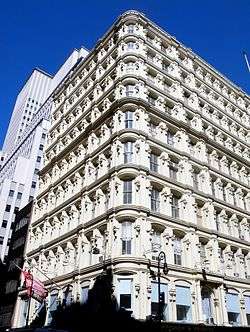Bennett Building (New York City)
The Bennett Building is a New York City designated landmark[1] in the Financial District of Lower Manhattan, New York City. The building is located along Nassau Street, for the entire block from Fulton Street to Ann Street. Having frontage on all three streets, it has three street addresses: 93-99 Nassau Street, 139 Fulton Street, and 30 Ann Street. Its key feature is a fully realized cast-iron facade, the largest known such example.[2][3]
| Bennett Building | |
|---|---|
 (2010) | |
%26groups%3D_c9d65d31cf0f0afb2edbd63b2763f0865b5374a4.svg)
| |
| General information | |
| Location | 93-99 Nassau Street Manhattan, New York City |
| Height | 125' |
| Technical details | |
| Floor count | 11 |
The building's three fully designed facades face Fulton, Nassau, and Ann Streets. The fourth side, facing an adjacent property, has a mostly blank facade.
History and description
The building is a ten-story (plus penthouse) cast-iron loft building. It was originally seven stories, with a smaller footprint.
It was commissioned by James Gordon Bennett Jr., the publisher of the New York Herald newspaper. The architect was Arthur D. Gilman, and is his only remaining work in Manhattan.[Notes 1] He designed it in the French Second Empire style. Constructed in 1872-73 at six stories, the mansard roof was removed and three floors and a penthouse were added in 1890-92 by James M. Farnsworth for the building's new owner, John Petit. In 1894, Farnsworth constructed an extension of the building to Ann Street. In both cases, Farnsworth's additions carefully followed Gilman's original design.
On November 21, 1995, the New York City Landmarks Preservation Commission designated the building a New York City landmark.[1]
The Bennett Building is the tallest building in the world with an entirely cast-iron facade.[1][2][3]
Historical marker
In 1916, the Maiden Lane Historical Society erected a plaque on the building that reads:[4]
Nassau Street
Known originally as
“The Street that Runs by the Pye Woman”
And was named in honor of
The House of Nassau
Whose head at the time was
William the Third
King of England
And sometime Stadtholder of the Dutch Republic
Nassau Street became identified with
The jewelry trade
More than half a century ago.
Layout
The building's vertical layout includes:[1]
- Basement (actually at street level, and has appearance of first floor), with cast iron facade and pillars mostly hidden by new materials
- Six original floors, with detailed cast iron facade, originally topped by a since-removed mansard roof. The original external entrances were up one flight of stairs, to the "first" floor, which gives the appearance of a second floor. The first floor details are different than the other five floors, with wider windows bays that are not recessed.
- Three additional upper floors of similar design (1890-92)
- Masonry penthouse of two stories (one full story and one partial story), set back and not visible from street level
- The second addition (the extension to Ann Street), was constructed with all floors at once, from basement to penthouse
References
Informational notes
- The St. John's Church in Staten Island was also designed by Gilman, and possibly its rectory; both still stand and are also landmarked, as of 2016. His Equitable building was significantly modified over time, then destroyed by fire in 1912.
Citations
- Harris, Gale (November 21, 1995). "Bennett Building Designation Report" (PDF). New York City Landmarks Preservation Commission.
- Bennett Building at Emporis
- White, Norval; Willensky, Elliot & Leadon, Fran (2010). AIA Guide to New York City (5th ed.). New York: Oxford University Press. ISBN 978-0-19538-386-7. p.41
- "Nassau Street, Manhattan". Forgotten New York. Retrieved 2018-05-07.
External links
